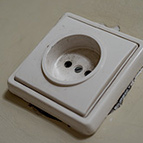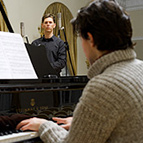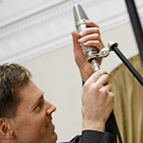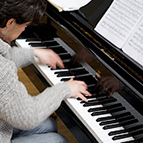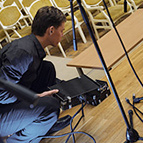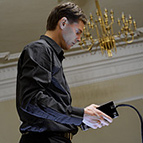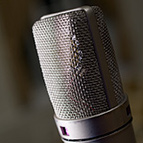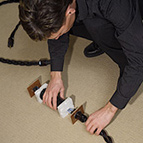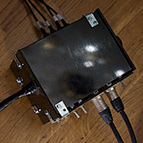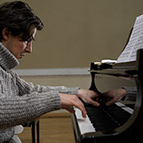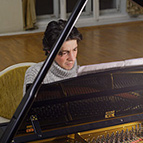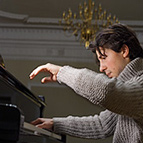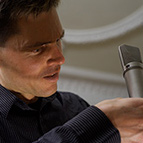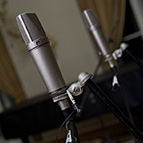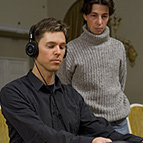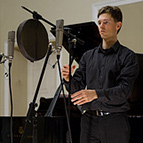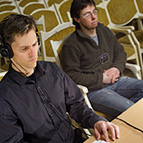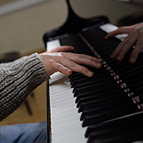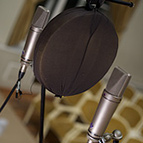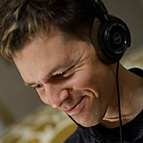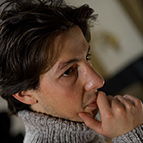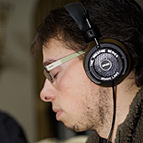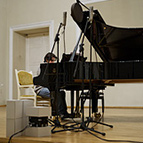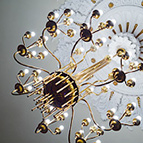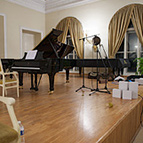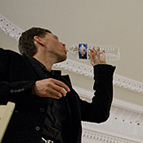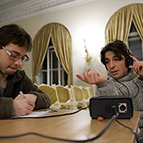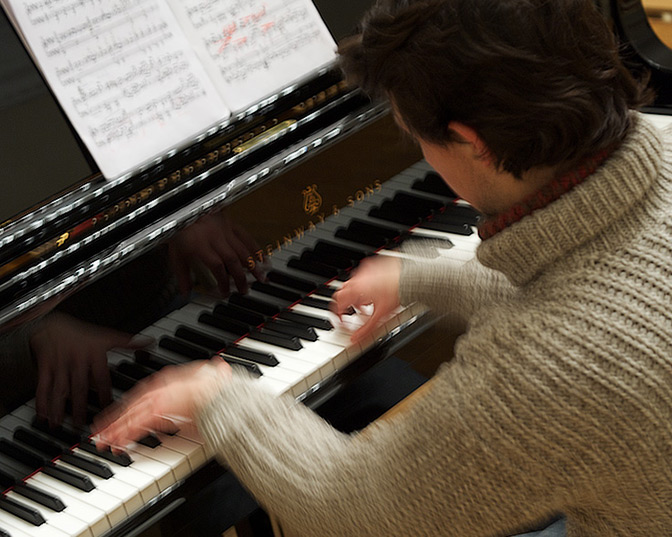 Steinway & Sons grand piano recordingTrack price: FREEThree excerpts from Franz Liszt's Mephisto Waltz No. 1
Experience the full dynamic spectrum of the symphonic power available from
one of the most versatile musical instruments ever created.
Download three excerpts of this amazingly pristine grand piano recording. The audio quality will speak for itself. You shall notice a disturbance in the right channel. This had to do with the faulty electrical wiring of the facilities (there was no ground) and we could not manage to keep this disturbance from entring the audio recording. It is interesting to note that, like typical record pops and dust noise, it is an event entirely divorced from the audio event. The very low amount of jitter and background noise make this radio interference signal all the more evident. With usual recording gear, such low-level radio intereference would be buried beneath a larger layer of random noisiness of the gear itself. Here in this recording, using the LessLoss DFPC Signature power cords, the Firewall and Blackbodys, we have no such typical gear noise to speak of. In Excerpt #1, notice at 50 seconds how the harmonics of the sustained strings remain true to the nature of the piano's natural sound, even when suspended this long. Notice the sound of the pedal action and the beauty of the wood sound of the hammers' action. And, at 2'50", notice how dead-on the harmonic content of the suspended strings is, with no artificial wavering or high frequency fluctuation. The recording seems as stable as the grand piano is heavy. Nobody would dare say that this recording sounds "digital" in the derogatory sense of the word. At 13 seconds in Excerpt #2, marvel at the absolutely clear double-hand chords played at full fortissimo, and then the sudden grand pause at 16 seconds, giving testament to the dynamic power of a Steinway grand. Notice also how the overtones fade off in a natural way and are not "manipulated" by the recording technology. At 50 seconds, we get another glimpse into what "clear attack" can mean when the gear is fed via the DFPC Signatures and conditioned by the Blackbodys. This sound quality has the word natural written all over it. In Excerpt #3, you can almost feel the natural tension in the strings, and how the wooden frame of the Steinway gives the real resonant body sound of this instrument. No one will doubt that this instrument is a fine one, and that the sound of a piano has as much to do with the quality of the body and the strings as with the hammers and their action. At 37" to 50", we have 13 seconds to marvel at the delicate sustain in the left hand, completely untouched by the recording technology. So intimate. Enjoy the power of the very end, too. You will hear the subdued applause of the only two audience members in attendance. LessLoss Technologies used for this recordingThe famous Steinway & Sons Grand Piano was recorded in very high quality using the DFPC Signature, Firewall, and Blackbody.
Piano: Viktoras Paukstelis What you can have heard here had you have been here to here hearThis is an excerpt from a recording session we had with concert pianist Viktoras Paukstelis. In this episode, you will hear the magnificent colorful overtones of the concert grand as the sustain pedal is pressed, revealing the sublime beauty and intricacies of tone quality available to the pianist. Then it explodes into the final round of closing powerful chords which end Franz Liszt's famous Mephisto Waltz. On pianos, percussion, and expressionOften times people (especially beginners) consider the piano, the percussion instrument which it rightly is, to have only two parameters of expression: velocity and sustain length. The established pianist will realize that he is playing 'the room' as well, and that part of the real art of supreme piano playing is the adjustment to the venue and playing with one's own reverberation there. Thus, the simple hammer strikes become an adventure into the poetry and mystery of acoustics as a means of expressing the essence of existance. "Music is the one incorporeal entrance into the higher world of knowledge which comprehends mankind but which mankind cannot comprehend." -- Ludwig van Beethoven, 1810 We hope to soon record the Moonlight Sonata in this quality. |
- Products
- Power Cables
-
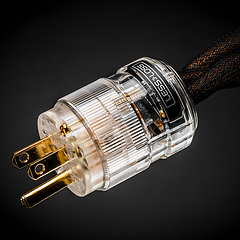 C-MARC™ Prime
The must have foundation for any sound system today.
From
$
486
C-MARC™ Prime
The must have foundation for any sound system today.
From
$
486
-
 C-MARC™ Classic
The unique super-cable power cord everyone's talking about.
From
$
1148
C-MARC™ Classic
The unique super-cable power cord everyone's talking about.
From
$
1148
-
 C-MARC™ Classic Entropic Process
The peerless, advanced Classic masterpiece.
From
$
1934
C-MARC™ Classic Entropic Process
The peerless, advanced Classic masterpiece.
From
$
1934
-
 C-MARC™ Stellar Entropic Process
The crown jewel for highest performance power connection.
From
$
2450
C-MARC™ Stellar Entropic Process
The crown jewel for highest performance power connection.
From
$
2450
-
- Loudspeaker Cables
- Interconnect Cables
-
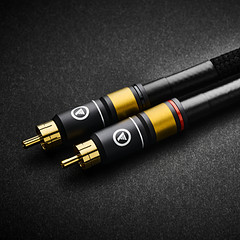 RCA C-MARC™
Cotton-clad true Litz • Whopping 2.3mm2 polarities
From
$
850
RCA C-MARC™
Cotton-clad true Litz • Whopping 2.3mm2 polarities
From
$
850
-
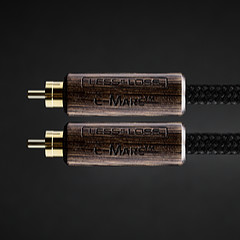 RCA C-MARC™ Entropic Process
Our finest RCA cable • Polished Wenge barrels
From
$
1428
RCA C-MARC™ Entropic Process
Our finest RCA cable • Polished Wenge barrels
From
$
1428
-
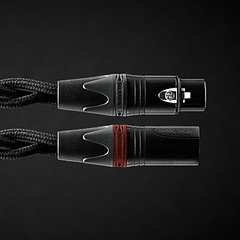 XLR C-MARC™
A hand-braided cotton-clad unique Litz construction
From
$
950
XLR C-MARC™
A hand-braided cotton-clad unique Litz construction
From
$
950
-
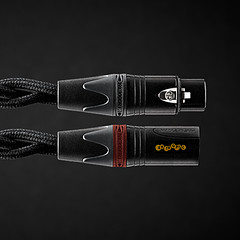 XLR C-MARC™ Entropic Process
Stratospheric performance for the audio connoisseur
From
$
1615
XLR C-MARC™ Entropic Process
Stratospheric performance for the audio connoisseur
From
$
1615
-
- Digital Cables
-
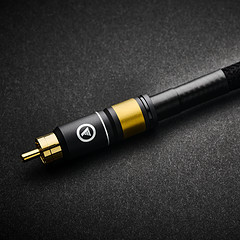 RCA Digital C-MARC™
Cotton-clad unique Litz design • Made only by LessLoss
From
$
510
RCA Digital C-MARC™
Cotton-clad unique Litz design • Made only by LessLoss
From
$
510
-
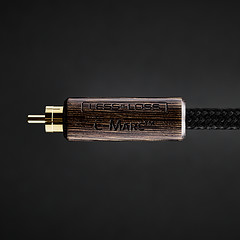 RCA Digital C-MARC™ Entropic Process
Possibly the most subtle digital cable on the planet
From
$
858
RCA Digital C-MARC™ Entropic Process
Possibly the most subtle digital cable on the planet
From
$
858
-
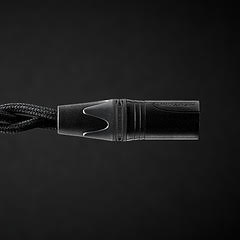 XLR Digital C-MARC™
Featuring a whopping 3 x 2.3mm2 Litz construction
From
$
570
XLR Digital C-MARC™
Featuring a whopping 3 x 2.3mm2 Litz construction
From
$
570
-
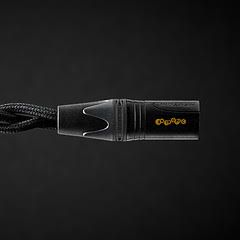 XLR Digital C-MARC™ Entropic Process
Stratospheric performance for the audio connoisseur
From
$
969
XLR Digital C-MARC™ Entropic Process
Stratospheric performance for the audio connoisseur
From
$
969
-
- Grounding Cables
- Bulk Wire and Cable
- Signal Conditioners
-
 Firewall for Loudspeakers
Firewall for Loudspeakers
C-MARC™ Plug-and-Play Speaker signal conditioning like you've never imagined From $ 1656 -
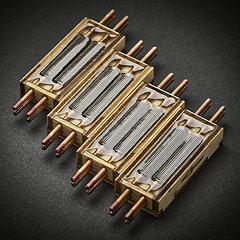 Firewall for Loudspeakers
Firewall for Loudspeakers
DIY version for Self-Installation For the Do-It-Yourself project enthusiast • Solder yourself From $ 800 -
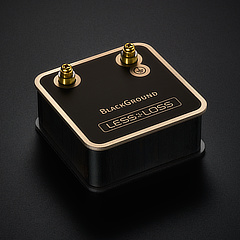 BlackGround DIY
Voltage-ground interface for a variety of applications
From
$
446
BlackGround DIY
Voltage-ground interface for a variety of applications
From
$
446
-
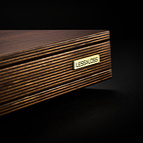 BlackGround 8x/10x Speaker Base
Plug-and-play loudspeaker signal conditioner
From
$
3096
BlackGround 8x/10x Speaker Base
Plug-and-play loudspeaker signal conditioner
From
$
3096
-
- Power Conditioners
-
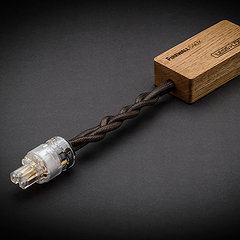 Firewall 640x
Plug-and-play solution for any powered gear
Firewall 640x
Plug-and-play solution for any powered gear
C-MARC™ Entropic Process and standard lead versions From $ 654 -
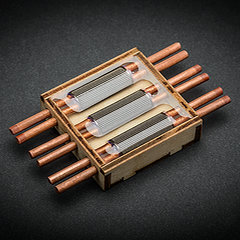 Firewall 640x DIY for Self-Installation
Self-solder and save!
From
$
320
Firewall 640x DIY for Self-Installation
Self-solder and save!
From
$
320
-
 BlackGround DIY
Voltage-ground interface for a variety of applications
From
$
446
BlackGround DIY
Voltage-ground interface for a variety of applications
From
$
446
-
 BlackGround 6x/10x Power Base
Plug-and-play power conditioner
From
$
2350
BlackGround 6x/10x Power Base
Plug-and-play power conditioner
From
$
2350
-
- Power Distributors
- Equipment Feet
- Field Conditioner
- DACs
- Power Cables
- Reviews
- This is definitely the cable to go for. It will almost literally blow your mind. – March 2012, Puresound Magazine
-
I was intrigued by the unanimously positive reviews garnered by these products ...
– by user Raymond Eye
Leaves you speechless
Sensational cables
BEST purchase I've made
Top notch performance
It's a steal
Musical... liquid... 3D
It's not subtle
More than an upgrade
Best I've heard so far
Stellar service
Sounds like a new system
Much more lifelike
Emotional flow
Overwhelming results
More dimensional
Sound is transformative
We were all astounded
Transformed my listening
Sounds so cohesive
Emotionally engaging
- Where to Start
- Free Newsletter
- Newsletter Archive
- B-Stock Alerts
- Shopping Tools
-
Shipping
- Free Shipping Learn about our international shipping policy
-
Return Options
Our satisfaction guarantee
and return policy -
Customs / Tax
UPS expedites local
customs clearance
-
Transaction
- Conditions of Sale Agreement for a smooth business transaction
- Privacy Policy We pledge to keep your information private
-
Terms of Use
Business policies
and agreements
-
Account
-
- Contact Us
-
Meet the Designers
-
- Care to share of your personal experience with our products? We'd be happy to post it!
- Want to learn more about our activities? Our Newsletter is both free and spam-free.
hi-res photos, brochures
logos, press releases, and
print-friendly PDF downloads. -
Contact Us
Connect with Us
-
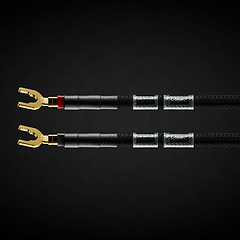
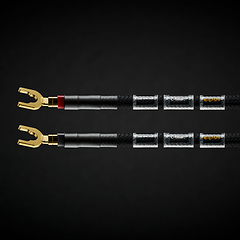

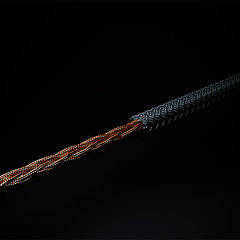
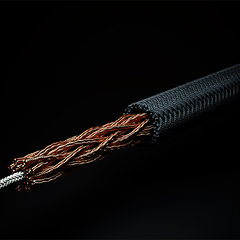
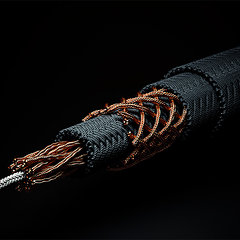
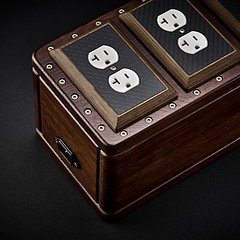
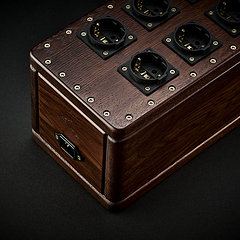

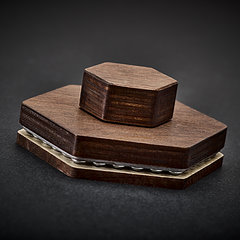
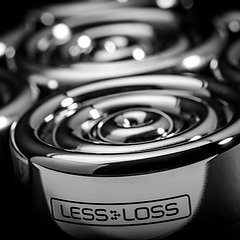
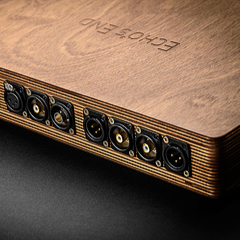
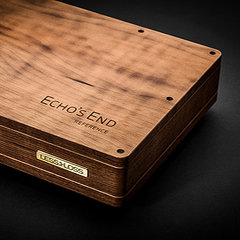
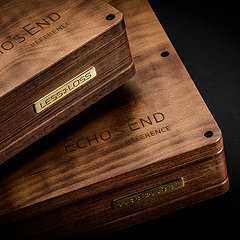
 Beware of Fakes
Beware of Fakes

